Dell UltraSharp U2711: Quality has a Price
by Jarred Walton on January 22, 2010 2:00 AM EST- Posted in
- Displays
Dell U2711 Color Quality
We'll start with a look at the color quality of the U2711, broken down into two areas: Color gamut and color accuracy (i.e. Delta E). We'll start by explaining the former. Color gamut refers to the ability for a display to represent all of the colors in a defined selection of colors. In this case, we use the Adobe RGB standard to define the base gamut, and we measure the percentage of that standard that a display is able to cover - higher being better.
Delta E is the difference between a requested color and the color that actually appears on the display, with lower being better - i.e. the displayed color doesn't have a large delta relative to what was requested. If a display has perfect color accuracy, Delta E will be 0.0; in practice, anything less than 1.0 is nearly perfect and no one will notice the difference. A Delta E of 2.0 or less is the desired result after calibration, meaning no one color measures higher than 2.0 on our standard 24 color palette. Such a result would be fit for use in any professional imaging environment. Finally, while Delta E of around 4.0 is visible to the naked eye, it's really a question of reference points; if you don't have something better nearby and you're not going to print or view content on other media, a result where all colors measure 4.0 or less is very good.
So how does the U2711 do in these areas? First let's look at the charts, and then we'll discuss what they mean. We used the Graphics and Adobe RGB setting on the U2711, with brightness set at 36% (~200nits) and contrast at the default 50%.

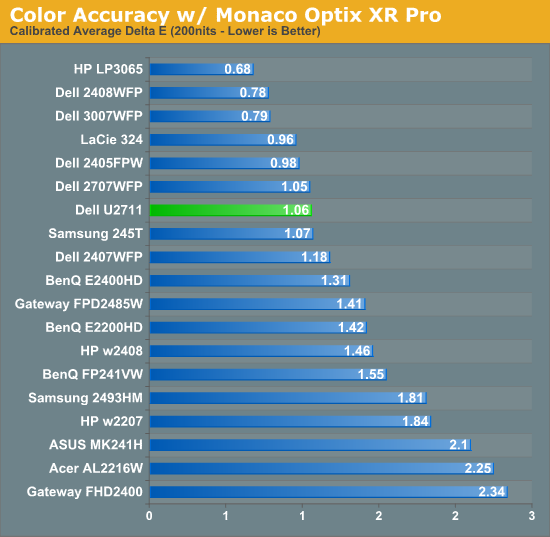
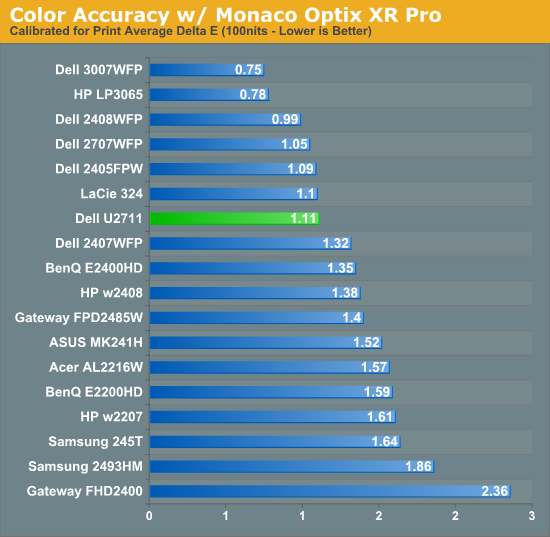
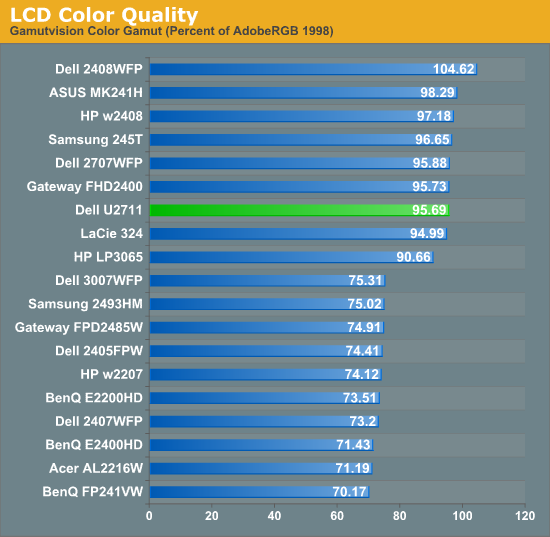
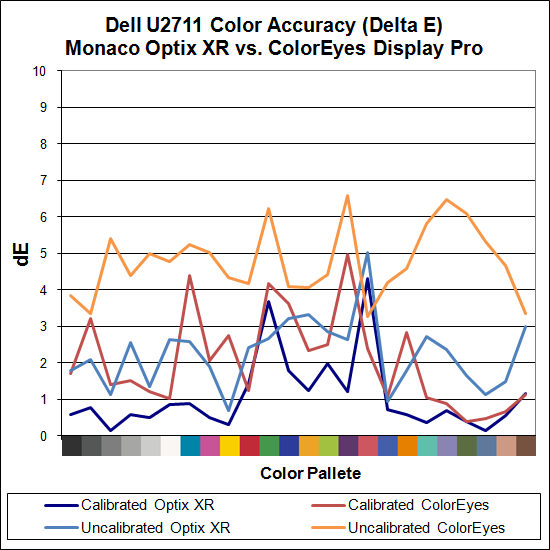
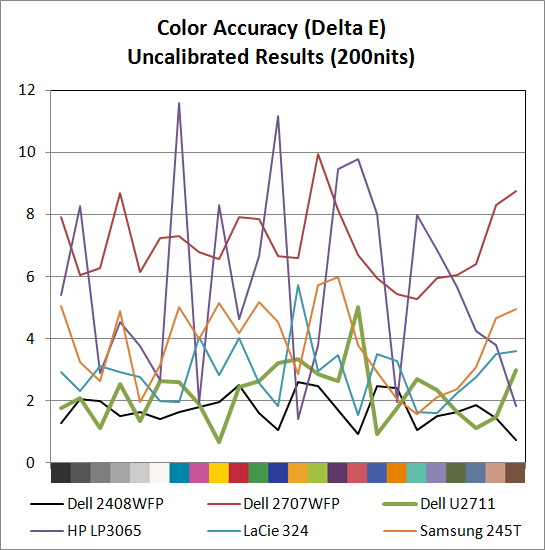
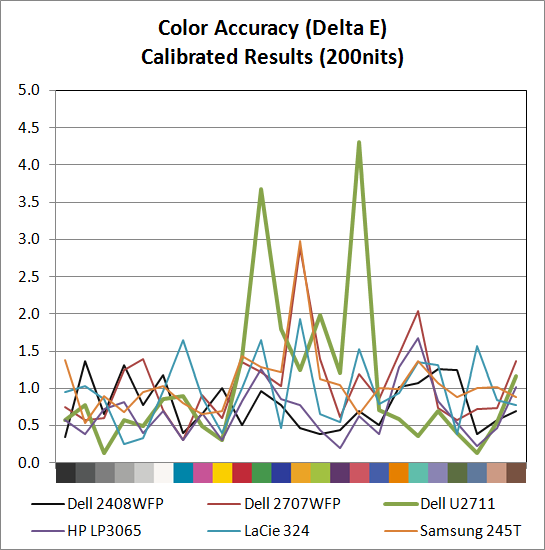
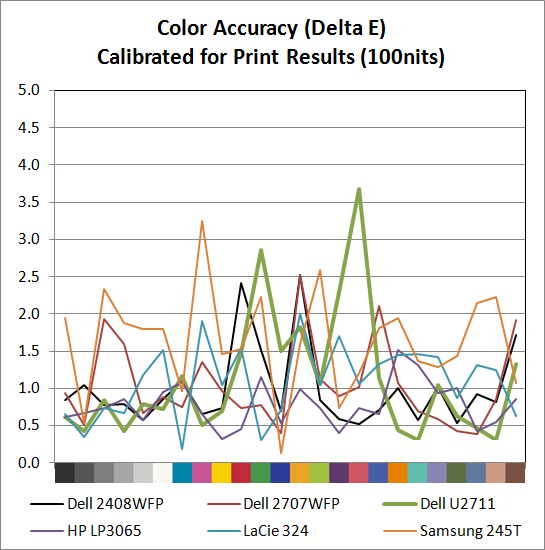
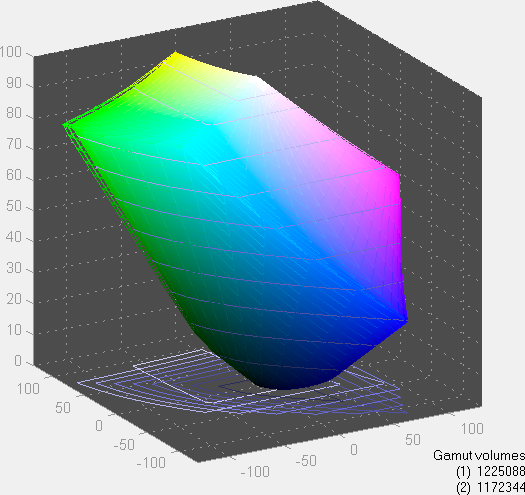
The U2711 scores extremely well in color gamut, and it achieves the 96% of Adobe RGB that Dell claims in their literature (not that most users would really notice the difference between any of the displays rated 90% to 105% - at least not after you eliminate the TN panels). Color accuracy on the other hand is a bit of a mixed bag. Dell ships a paper with test results showing the color calibration of each individual U2711, with the claim that the displays will have an average Delta E of less than 5.0 without any end-user calibration (when using the sRGB and Adobe RGB settings). Dell uses Minolta Color Analyzer CA210 and 32 test colors while we test with ColorEyes Display Pro and Monaco Optix XR Pro and 24 test colors, but our Monaco results confirm their claim. We're not sure why, but we continue to get better results using Optix XR Pro than with ColorEyes Display Pro.
As far as Optix is concerned, the U2711 achieves the rated Delta E of < 5.0 at just 2.24 without calibration, which is an excellent result. In fact the U2711 has no colors in the standard Gretag Macbeth 24 color palette score higher than 5.0 (and only reddish-pink scores a 5.0 measurement). The only LCD we've tested that did better is Dell's own 2408WFP (which also, interestingly enough, had an Adobe RGB color gamut of 105%). ColorEyes also gives an average Delta E of less than 5.0, but at 4.78 the score isn't nearly as remarkable, with nine color measurements well above 5.0. The uncalibrated (Monaco) results put the U2711 ahead of the HP LP3065, Dell 2707WFP, Samsung 245T, and LaCie 324 - and just about every other LCD we've tested.
Switch to the calibrated results and the U2711 doesn't impress quite as much relative to the competition. Monaco gives the U2711 an average Delta E of 1.06, which is great, but there are two results above 3.0 (the worst is reddish-pink again, this time at 4.31) compared to displays like the HP LP3065 where the highest measured Delta E is just 1.68. Dell's own 2707WFP, a three-year-old offering, also delivered a similar average Delta E but with only two colors above 2.0 (and still under 3.0). For a better LCD (i.e. not a TN panel), the results are really only slightly above average. It is possible different calibration software would achieve a better end result, but really we're talking about a "problem" that only the most demanding users are likely to ever notice.
Color Consistency
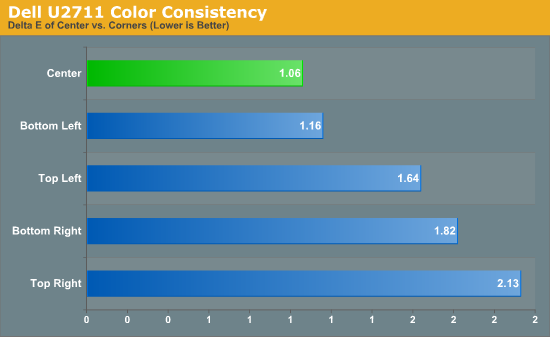
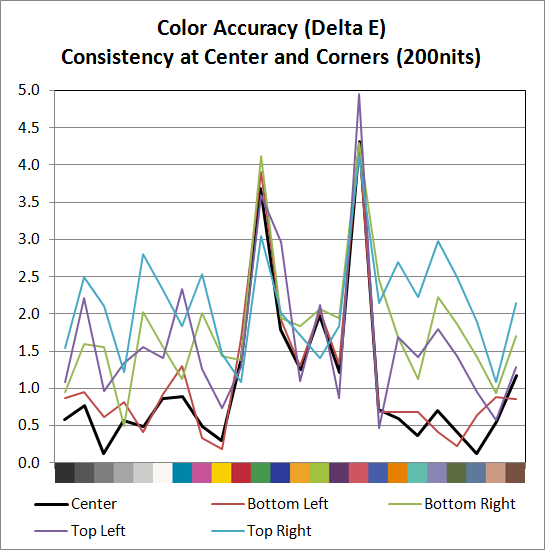
We added another test to try and measure the panel consistency across the entire surface. We measure Delta E at the center of the display, but what happens on the edges? To test this, we used the same profile generated in our best Delta E test result and measured Delta E again at the four corners. Most of the scores are similar, with a slight increase in average Delta E relative to the center measurement. The bottom-left corner is nearly identical to the center measurement, the top-left and bottom-right are a bit worse, and the top-right corner gets the overall worst result. While on the one hand we could say that the Delta E on the top-right is twice that of the center measurement, it's not a case of being "twice as bad". In fact, the color consistency is very good, and we didn't notice any "hot spots" are areas where the colors were clearly off relative to the rest of the LCD.










153 Comments
View All Comments
blyndy - Friday, January 22, 2010 - link
I've been keen on this monitor since it was announced.However it may use the same panel as the 27" apple imac, which has gotten alot of complaints of yellow tinging on the bottom half.
A few user reviews with multiple units are in order.
JarredWalton - Friday, January 22, 2010 - link
Remember that the Apple version uses a completely different backlight, so even if the glass substrate is the same the two displays can't be directly compared. Yellow tinging on the bottom half is a backlight problem (and possibly a design issue).gadgetdan - Sunday, August 8, 2010 - link
Hi,Just got this monitor on order now, for use with my new computer I am yet to buy (chose monitor first). I have not seen any comments regarding video cards to drive this one. I have read about this monitor and seen recommendations to run this with 2 DVI-D cables to get full use of the resolution. I am considering the ATI 5770 card, which should handle this resolution according to the specs. I would be interested in hearing from anyone who has any experience on this card/monitor combination or any other input to a suitable videocard to make justice to this monitor.
Thanks!
/Dan
krotchy - Monday, August 9, 2010 - link
Dan,You need a Dual-Link DVI cable, not 2 DVI-D cables to run this monitor, basically it is a single DVI-D cable containing both channels. A Dual Link DVI cable is included with the monitor, but if you want more information I recommend you check the wikipedia article on DVI...
However, at work we have ordered/installed about 20 of these so far and I am finding that DisplayPort is a much more convenient connection mechanism than DVI since a lot of the computers we are finding actually contain only single-link DVI outputs or other issues such as underpowered cards which max our at 1600x1200 over DVI. It does seem though that any card we find with displayport can do 2560x1440 despite some of them being relatively underpowered compared to other cards that dont seem to reach 2560x1440.
gadgetdan - Saturday, August 28, 2010 - link
krotchy,Thanks for your comments, this is very useful for me.
/Dan
S8 - Tuesday, October 19, 2010 - link
I have a problem using the Dell U27 as a second monitor for an iMac 27. The Dell U27 doesn't let me choose its max resolution 2560 x 1440. I am using a DVI display adapter from Apple.Thanks for any help.
chiadog - Monday, October 25, 2010 - link
"I am using a DVI display adapter from Apple"You need the active dual link DVI adapter, not the cheap single link one. Just get mini DP to DP dongle and call it a day.
sarangiman - Saturday, January 1, 2011 - link
I have the Dell U2711 & have read a number of reviews where people keep mentioning the AdobeRGB & sRGB modes. Yet none of these articles state what monitor profile to set in the operating system when using these modes!Is it so obvious that it doesn't need to be mentioned? What am I missing?
I spoke to a # of people at Dell Tech Support & they had no idea what I was talking about. We started debating it over here: http://forums.whirlpool.net.au/archive/1511987. Don't think we reached a consensus.
I can personally state that when I set the monitor to AdobeRGB mode, & then set the monitor profile in the OS to AdobeRGB (HERESY in the world of color management; that is, to assign a device independent profile to a, um, device), I get the same colors as when I set the monitor to sRGB while setting the monitor profile in the OS to sRGB. These leads some credence to the belieft that one should set the monitor profile to the emulation mode being chosen. What I'm trying to get at here is that maybe Dell created these modes not only to limit the gamut of the monitor, but also to make a mode where the monitor's color response can be reasonably described by the sRGB or AdobeRGB profiles... This would make it easy for people to have somewhat accurate colors without profiling their monitors (so would a good profile in 'standard' mode, or what have you).
I realize that the best option when using the emulation modes is still to profile the monitor & use that profile. But I'm wondering if one can get away with using the emulation mode as long as you select the proper corresponding profile in the OS.
Does anyone know the answer to this?
Many thanks in advance!
Rishi
sarangiman - Saturday, January 1, 2011 - link
I have the Dell U2711 & have read a number of reviews where people keep mentioning the AdobeRGB & sRGB modes. Yet none of these articles state what monitor profile to set in the operating system when using these modes!Is it so obvious that it doesn't need to be mentioned? What am I missing?
I spoke to a # of people at Dell Tech Support & they had no idea what I was talking about. We started debating it over here: http://forums.whirlpool.net.au/archive/1511987. Don't think we reached a consensus.
I can personally state that when I set the monitor to AdobeRGB mode, & then set the monitor profile in the OS to AdobeRGB (HERESY in the world of color management; that is, to assign a device independent profile to a, um, device), I get the same colors as when I set the monitor to sRGB while setting the monitor profile in the OS to sRGB. These leads some credence to the belieft that one should set the monitor profile to the emulation mode being chosen. What I'm trying to get at here is that maybe Dell created these modes not only to limit the gamut of the monitor, but also to make a mode where the monitor's color response can be reasonably described by the sRGB or AdobeRGB profiles... This would make it easy for people to have somewhat accurate colors without profiling their monitors (so would a good profile in 'standard' mode, or what have you).
I realize that the best option when using the emulation modes is still to profile the monitor & use that profile. But I'm wondering if one can get away with using the emulation mode as long as you select the proper corresponding profile in the OS.
Does anyone know the answer to this?
Many thanks in advance!
Rishi
Robincm86 - Friday, June 17, 2011 - link
Good:Superb quality for photo, games and videos, plenty of port connectivity options, attractive looks.
Thumbs Down:
Outcome:
Dell UltraSharp U2711 is a bit costly but looking at the performance, quality and the ports we will definitely recommend you this panel. Get this panel if you have enough money and if you don’t, then start saving! It is worth every bit of your hard earned money.
http://www.technicalnavigator.com/dell-ultrasharp-...